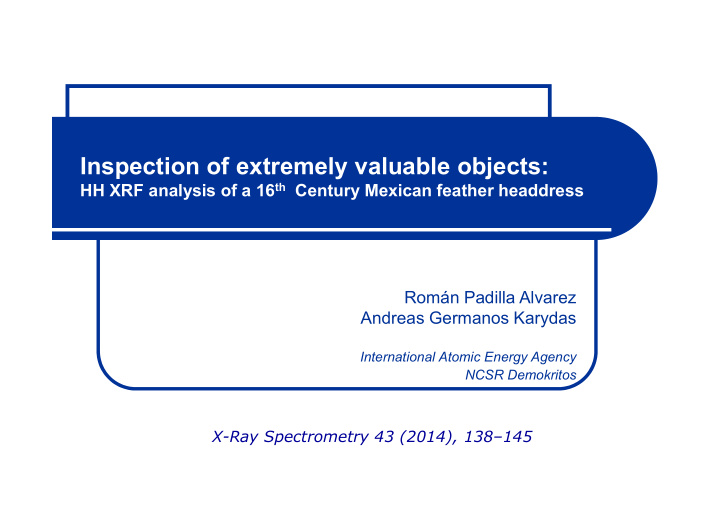



Inspection of extremely valuable objects: HH XRF analysis of a 16 th Century Mexican feather headdress Román Padilla Alvarez Andreas Germanos Karydas International Atomic Energy Agency NCSR Demokritos X-Ray Spectrometry 43 (2014), 138–145
Outline: Description of the object Analytical problems Identification of pigments in feathers Verification of authenticity of gold decorations Study of the fake ornaments Identification of pesticides in feathers Concluding remarks
16 th Century Mexican Feather headdress:
16 th Century Mexican Feather headdress: The 16th century feather headdress in the Museum of Ethnology Vienna is the most renowned of the few remaining pre-Columbian “Arte Plumaria” artefacts, which were made by feather artisans ( Amantecas ) using traditional techniques in the territory of present day Mexico. The recorded history of the headdress begins in 1596, when it is first mentioned in the estate inventory of the art collection of Archduke Ferdinand II of Tyrol at Ambras Castle . Due to its age, the variety of materials used, its history and former restoration treatments, the artefact today is one of the most sensitive and demanding objects of the museum. Concerning the study of the piece itself the emphasis lies on the identification of manufacturing techniques, the various materials, the old restoration measures and its conservation. Handheld x-ray fluorescence (XRF) analyzers are extremely useful for the study of art works in museum collections. The possibility of bringing the instrument to inspect the objects in the site facilitates the study of artefacts that cannot be moved either due to their extreme fragility or due to their large size and/or weight. In addition non-destructive analysis constitutes a preferred alternative to invasive sampling techniques, which are usually not allowed in the study of unique or extremely valuable objects.
Aim of the study: • Revealing the presence of inorganic toxic elements that could be associated to the use of pesticides in past conservation interventions, • Identifying pigments on the structural elements of the object • Distinguishing the authentic gold and the gilded brass ornaments, which were added in the 19th century.
Experimental: Handheld XRF (Niton XL3t, GOLDD): • miniaturized air-cooled X-ray tube (thin Ag anode in transmission geometry) • Max. operational values: 50 kV, 200 m A, 2.5 W • SDD detector (30 mm 2 , 178 eV) Measurement conditions: • Main: 50 kV, filtered • Light: 8 kV, unfiltered
Inspected areas in the feather ornaments Measurements were taken at different spots, including original feathers and areas where restoration actions were made in the past
Inspected areas in the feather ornaments Keratin contains numerous primary di-sulfide cross linkages Cl, K and Ca are also abundant in the feathers
Main findings in the feather ornaments • There were not found evidences on use of inorganic pigments, • The elements of the object that were restored in XIX [1] seem to be treated with pesticides, most probably arsenic soaps, bromadiolone and lead arsenate [2] 1. Hochstetter, F. von, Über mexikanische Reliquien aus der Zeit Montezuma’s in der k.k. Ambraser Sammlung, in Denkschriften der philosophisch- historischen Klasse der kaiserlichen Akademie der Wissenschaften 35 Wien (1884). 2. Old poisons, new problems: A museum resource for managing contaminated cultural materials. Nancy Odegaard, Alice Sadongei and Assoc. Altamira Press, 2005, UK
Inspected areas in the feather ornaments As, Br and Pb are indicative of the use of pesticides for disinfestation of the feathers in previous treatments: arsenic soaps, bromadiolone, lead arsenate Methyl bromide and ethylene dibromide could also be used
Evidence of use of pesticides
Inspected metal ornaments Following x-ray radiography images, several metal ornaments were chosen for measurements, to include both high and less absorbing pieces
Gold ornaments
Gilded brass ornaments
Thickness of the Gild
Concluding remarks Fast screening results can be produced on the spot to answer different questions arising from the in-situ investigation, whereas a more detailed interpretation of the measurements carried out can be performed “off- line” to enhance significantly the information gathered from of the analysis • Original metal ornaments are from alloyed gold (Au: 75-85, Ag: 10–17, Cu: 2.5–5.5 %). • Many replacements have been identified as gilded brass. Brass composition (Cu: 66-68, Zn: 31-34, Pb: 0.04–0.8 %), Gold layer thickness was found < 2 microns.
Acknowledgements Local authorities and organizers.
Thanks for your time and attention…
Recommend
More recommend